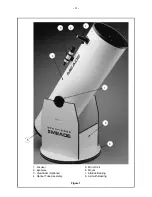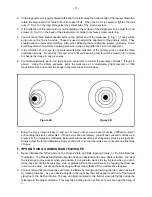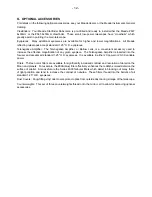
- 11 -
I. OBSERVING GUIDELINES
Several basic guidelines should be followed for best results in using your telescope:
1.
Try not to touch the eyepiece while observing. Any vibrations resulting from such contact will
immediately cause the image to move.
2.
Allow your eyes to become “dark-adapted” prior to making serious observations. Night adaptation
generally requires about 10-15 minutes for most people.
3.
Let the telescope “cool down” to the outside environmental temperature before making observations.
Temperature differentials between a warm house and cold outside air require about 30 minutes for the
telescope’s optics to regain their true correct figures. During this period the telescope will not perform
well.
4.
If you wear glasses and do not suffer from astigmatism, take your glasses off when observing through
the telescope. You can re-focus the image to suit your own eyes. Observers with astigmatism, however,
should keep their glasses on, especially with lower powered eyepieces. The effects of astigmatism are
reduced with higher power eyepieces, so eyeglasses may be removed to improve eye relief.
5.
Avoid setting up the telescope inside a room and observing through an open window (or, worse yet,
through a closed window!). The air currents caused by inside/outside temperature differences will make
quality observing impossible.
6.
Perhaps most importantly of all, avoid “overpowering” your telescope. The maximum usable magnifica-
tion at any given time is governed by the seeing conditions. If the telescopic image starts to become
fuzzy as you increase in power, drop down to a reduced magnification. A smaller, but brighter and
sharper, image is far more preferable to a larger, but fuzzy, indistinct one.
As you use your telescope more and more, you will find that you are seeing more and finer detail: observing
through a large-aperture telescope is an acquired skill. Celestial observing will become increasingly
rewarding as your eye becomes better trained to the detection of subtle nuances of resolution.
J. CARE OF OPTICS AND MAIN TUBE
With the reasonable care due any fine instrument, your Meade telescope will last a lifetime. If the eyepieces
become dirty, try cleaning them with a camel’s hair brush or compressed air. If you must wipe the surface
of the lenses, do so gently with a soft cloth so as not to scratch the protective coatings.
The aluminum coating on the primary and secondary mirrors may last more than ten years without significant
deterioration. (The coatings will last a shorter period if regularly exposed to salty or polluted air.) Minor
blemishes, scratches, or streaks will NOT impair the telescope’s performance. Re-coating, when necessary,
is relatively inexpensive. Contact your local Meade dealer for information on mirror re-coating services.
The most common error is to clean the optics too often. If cleaning does become necessary, clean as
follows:
1.
Using distilled water and cotton, gently swab the surface of the mirror to remove any dust or dirt. Use
the cotton to make one pass over the mirror and then use new cotton. This will keep the dirt previously
removed from contacting the mirror surface and scratching the coatings.
2.
Dip a wad of cotton in a mild detergent solution (1/2 teaspoon to 1 pint of water) and gently swab the
entire surface. This will remove any oily deposits or fingerprints.
3.
Swab the entire surface. Do not turn over the cotton wads or dissolved skin oils may deposit on the
mirror’s surface. Immediately take a dry swab and continue wiping the entire surface gently. Keep
changing wads until the mirror surface is completely dry and free of streaks.
When cleaning the outside of the Starfinder optical tube (1), use a mild detergent, (Pine-Sol, Formula 409,
Fantastic, or oil soap). Oil soap is preferred as it also acts as a preservative for the paint. Solvent or alcohol-
based cleaning solutions will diminish the original luster of the paint.
Summary of Contents for Starfinder 16
Page 1: ...Meade Instruments Corporation Instruction Manual 16 Meade Starfinder Dobsonian Telescope ...
Page 13: ... 13 NOTES ...
Page 14: ... 14 NOTES ...
Page 15: ......


























